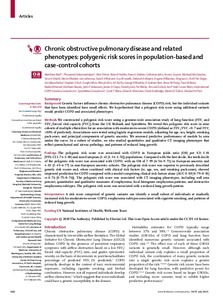| dc.contributor.author | Dudbridge F | |
| dc.contributor.author | Tobin MD | |
| dc.contributor.author | DeMeo DL | |
| dc.contributor.author | Tal-Singer R | |
| dc.contributor.author | Bakke P | |
| dc.contributor.author | Lahousse L | |
| dc.contributor.author | Won S | |
| dc.contributor.author | John C | |
| dc.contributor.author | Hansel NN | |
| dc.contributor.author | Gulsvik A | |
| dc.contributor.author | Wain L; International COPD Genetics Consortium; SpiroMeta Consortium | |
| dc.contributor.author | Obeidat M | |
| dc.contributor.author | Rich SS | |
| dc.contributor.author | Bartz TM | |
| dc.contributor.author | Kim WJ | |
| dc.contributor.author | Wijnant SRA | |
| dc.contributor.author | Weiss ST | |
| dc.contributor.author | Guyatt AL | |
| dc.contributor.author | Shrine N | |
| dc.contributor.author | McGeachie MJ | |
| dc.contributor.author | Moll M | |
| dc.contributor.author | Psaty BM | |
| dc.contributor.author | Barr RG | |
| dc.contributor.author | Meyers DA | |
| dc.contributor.author | Washko GR | |
| dc.contributor.author | Crapo JD | |
| dc.contributor.author | Lynch D | |
| dc.contributor.author | Do AR | |
| dc.contributor.author | Li X | |
| dc.contributor.author | Cho MH | |
| dc.contributor.author | Barnes K | |
| dc.contributor.author | Bleecker ER | |
| dc.contributor.author | Brusselle G | |
| dc.contributor.author | Sakornsakolpat P | |
| dc.contributor.author | Hobbs BD | |
| dc.contributor.author | Hall IP | |
| dc.contributor.author | Silverman EK | |
| dc.contributor.author | Hokanson JE | |
| dc.contributor.author | Manichaikul A | |
| dc.contributor.author | Gharib SA | |
| dc.date.accessioned | 2022-10-27T12:13:01Z | |
| dc.date.available | 2022-10-27T12:13:01Z | |
| dc.identifier.uri | https://www.utupub.fi/handle/10024/157080 | |
| dc.description.abstract | <p>
<strong>
Background:
</strong>
Genetic factors influence chronic obstructive pulmonary disease
(COPD) risk, but the individual variants that have been identified have
small effects. We hypothesised that a polygenic risk score using
additional variants would predict COPD and associated phenotypes.
</p>
<p>
<strong>
Methods:
</strong>
We constructed a polygenic risk score using a genome-wide association study of lung function (FEV<sub>1</sub> and FEV<sub>1</sub>/forced
vital capacity [FVC]) from the UK Biobank and SpiroMeta. We tested this
polygenic risk score in nine cohorts of multiple ethnicities for an
association with moderate-to-severe COPD (defined as FEV<sub>1</sub>/FVC <0·7 and FEV<sub>1</sub>
<80% of predicted). Associations were tested using logistic
regression models, adjusting for age, sex, height, smoking pack-years,
and principal components of genetic ancestry. We assessed predictive
performance of models by area under the curve. In a subset of studies,
we also studied quantitative and qualitative CT imaging phenotypes that
reflect parenchymal and airway pathology, and patterns of reduced lung
growth.
</p>
<p>
<strong>
Findings:
</strong>
The polygenic risk score was associated with COPD in European
(odds ratio [OR] per SD 1·81 [95% CI 1·74-1·88] and non-European (1·42
[1·34-1·51]) populations. Compared with the first decile, the tenth
decile of the polygenic risk score was associated with COPD, with an OR
of 7·99 (6·56-9·72) in European ancestry and 4·83 (3·45-6·77) in
non-European ancestry cohorts. The polygenic risk score was superior to
previously described genetic risk scores and, when combined with
clinical risk factors (ie, age, sex, and smoking pack-years), showed
improved prediction for COPD compared with a model comprising clinical
risk factors alone (AUC 0·80 [0·79-0·81] vs 0·76 [0·75-0·76]). The
polygenic risk score was associated with CT imaging phenotypes,
including wall area percent, quantitative and qualitative measures of
emphysema, local histogram emphysema patterns, and destructive emphysema
subtypes. The polygenic risk score was associated with a reduced lung
growth pattern.
</p>
<p>
<strong>
Interpretation:
</strong>
A risk score comprised of genetic variants can identify a small
subset of individuals at markedly increased risk for moderate-to-severe
COPD, emphysema subtypes associated with cigarette smoking, and patterns
of reduced lung growth.
</p> | |
| dc.language.iso | en | |
| dc.title | Chronic obstructive pulmonary disease and related phenotypes: polygenic risk scores in population-based and case-control cohorts | |
| dc.identifier.urn | URN:NBN:fi-fe2021042822629 | |
| dc.relation.volume | 8 | |
| dc.contributor.organization | fi=sydäntutkimuskeskus|en=Research Centre of Applied and Preventive Cardiovascular Medicine (CAPC)| | |
| dc.contributor.organization | fi=tyks, vsshp|en=tyks, vsshp| | |
| dc.contributor.organization | fi=väestötutkimuskeskus|en=Centre for Population Health Research (POP Centre)| | |
| dc.contributor.organization-code | 2607004 | |
| dc.contributor.organization-code | 2607008 | |
| dc.converis.publication-id | 51843210 | |
| dc.converis.url | https://research.utu.fi/converis/portal/Publication/51843210 | |
| dc.format.pagerange | 708 | |
| dc.format.pagerange | 696 | |
| dc.identifier.jour-issn | 2213-2600 | |
| dc.okm.affiliatedauthor | Dataimport, tyks, vsshp | |
| dc.okm.affiliatedauthor | Raitakari, Olli | |
| dc.okm.discipline | 3121 Internal medicine | en_GB |
| dc.okm.discipline | 1184 Genetics, developmental biology, physiology | en_GB |
| dc.okm.discipline | 3121 Sisätaudit | fi_FI |
| dc.okm.discipline | 1184 Genetiikka, kehitysbiologia, fysiologia | fi_FI |
| dc.okm.internationalcopublication | international co-publication | |
| dc.okm.internationality | International publication | |
| dc.okm.type | Journal article | |
| dc.publisher.country | United Kingdom | en_GB |
| dc.publisher.country | Britannia | fi_FI |
| dc.publisher.country-code | GB | |
| dc.relation.doi | 10.1016/S2213-2600(20)30101-6 | |
| dc.relation.ispartofjournal | The Lancet Respiratory Medicine | |
| dc.relation.issue | 7 | |
| dc.year.issued | 2020 | |
